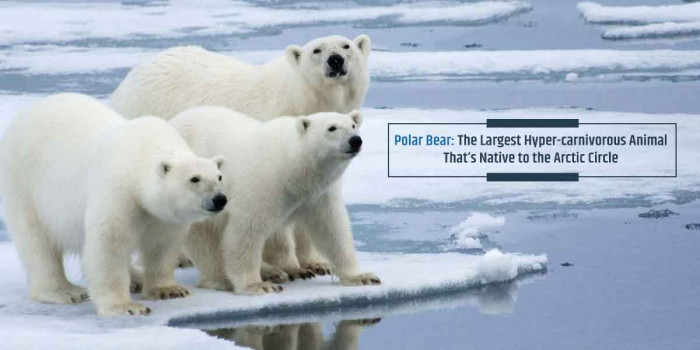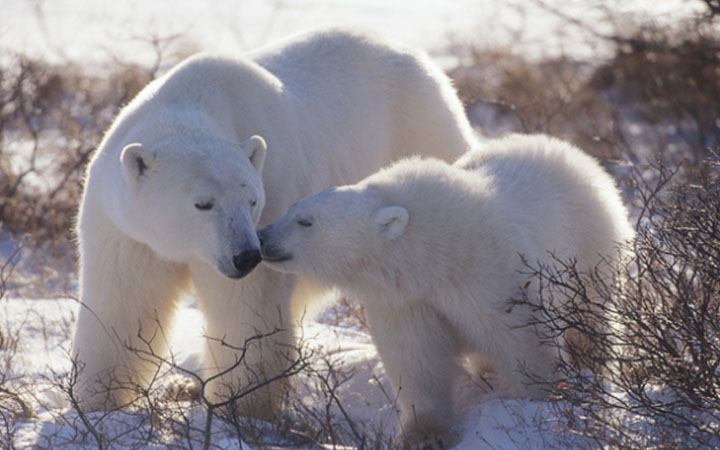7 Fascinating Facts About the Wonderfully Fluffy Polar Bear
Do you know that polar bears are not white but black? They’re bad hunters, can swim for several days, and are marine animals. Read more here.

Who doesn’t love polar bears- they’re wonderful, white, and fluffy!
Polar bears are the world’s largest hypercarnivores on the land, measuring up to 3 meters long. A sister species of the brown bear, it evolved around 150,000 years ago to inhabit a narrower ecological niche and adapt to cold temperature conditions.
Their Latin name, Ursus maritimus, refers to sea bear. Polar bears are referred to as marine mammals and spend a lot of their time on the sea ice and around water. The thick layer of their white fur keeps them warm.
Here are some more interesting facts about your favorite Arctic animal.
1. Polar Bears’ Hunting Capabilities

They are bad hunters, meaning their only 2% of their hunts are successful. They spend almost half of their life in hunting food.
Polar bears mainly eat ringed and bearded seals, which they can identify in the water beneath a meter of compacted ice and almost a kilometer away from it due to their strong sense of smell. They also feed on small mammals, carcasses, birds, vegetation, and eggs.
Reaching speeds up to 40 kph on land and 10kph in water, a swimming polar bear can jump 8 ft out of the water to catch a seal on land or in open water.
2. Male & Female Polar Bears’ Physical Characteristics
Male polar bears can weigh up to 800 kg, and female counterparts weigh usually half of that of the males. Also, male polar bears can weigh as much as ten men. A newborn polar bear weighs only around 0.68 kg.
It has non-slippery footpads and has the shortest tail among all the bear species. It has 42 teeth and has larger & sharper canines and smaller cheek teeth.
Its white fur coat eventually becomes yellow with age.
3. Climate Change is Just One of the Threats They Face

Climate change remains the biggest threat to the survival of the polar bears. Human-polar bear conflicts increased the melting sea ice as they look for food during summers.
The oil and gas industry poses the risk of habitat destruction due to its plans for oil exploration in the Arctic.
If a polar bear’s fur comes in contact with oil spills, its insulating effect can reduce requiring them more energy to keep warm. And it can also be poisonous if ingested.
Through prey, they are also at risk of being exposed to toxic chemicals like pesticides, and these can affect their reproduction ability and biological functioning.
4. Genetic Testing Confirms Grizzly-Polar Bears Hybrids’ Existence
According to the genetic testing in 2006, it was confirmed that polar bear-grizzly bear hybrids exist. They are also called grolar bears or pizzly bears.
This hybrid has a physical resemblance to the intermediate of both species. However, since wild hybrids are born from polar bear mothers, they behave like polar bears.
5. 19 Subpopulations of Polar Bear Exist

Nearly 26000 wild polar bears make up the total population, and they are divided into 19 units or subpopulations. Out of these, only one is increasing, five are stable, four are declining, and the remaining nine are not yet assessed due to lack of data.
6. They Can Swim Steadily for Long Distances for Several Days
Reaching speeds of up to 6mph in the water, polar bears can swim constantly for long distances for hours and even days to get an ice piece to another. Their big paws are specially adapted to swim, and they use them to paddle through the water while holding their hind legs flat like a rudder.
7. They Appear White But are Black

Interestingly, polar bears are black and not white. That’s because its fur is translucent and appears white as it reflects visible light. The skin beneath this fur is jet black.
Concluding Thoughts
The IUCN/World Conservation Union puts polar bears in the “vulnerable” conservation status, and they need to be conserved unless it would become an endangered species.
The animal kingdom is vibrantly diverse and has all kinds of creatures- wild, pet, and domestic.
Popular Posts
10 Biggest Water Dinosaurs & Sea Monsters Ever Found in Archaeology
The present-day ocean is certainly a scary place where giant sharks, whales, squids, barracuda, and numerous other marine creatures live.
Kimberly Campbell
6 Amazing Things We Should Learn From Camel Feet
Camels are a kind of mammals with the humped back, long legs, and lipped snout. They were domesticated nearly 3000 years ago are still used for transportation.
Kimberly Campbell
80 Most Popular Long Neck Dinosaurs Ever Recorded in History
Do you know the largest creatures ever walk on the earth were the long tailed and long neck dinosaurs which were called as Sauropods?
Kevin Green








